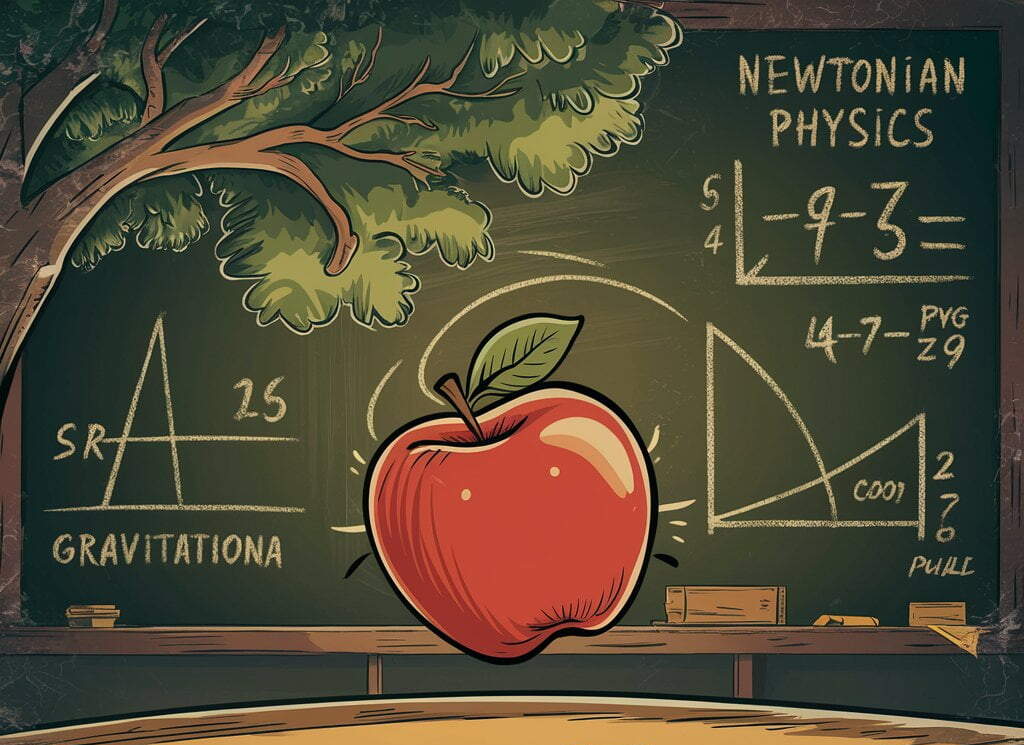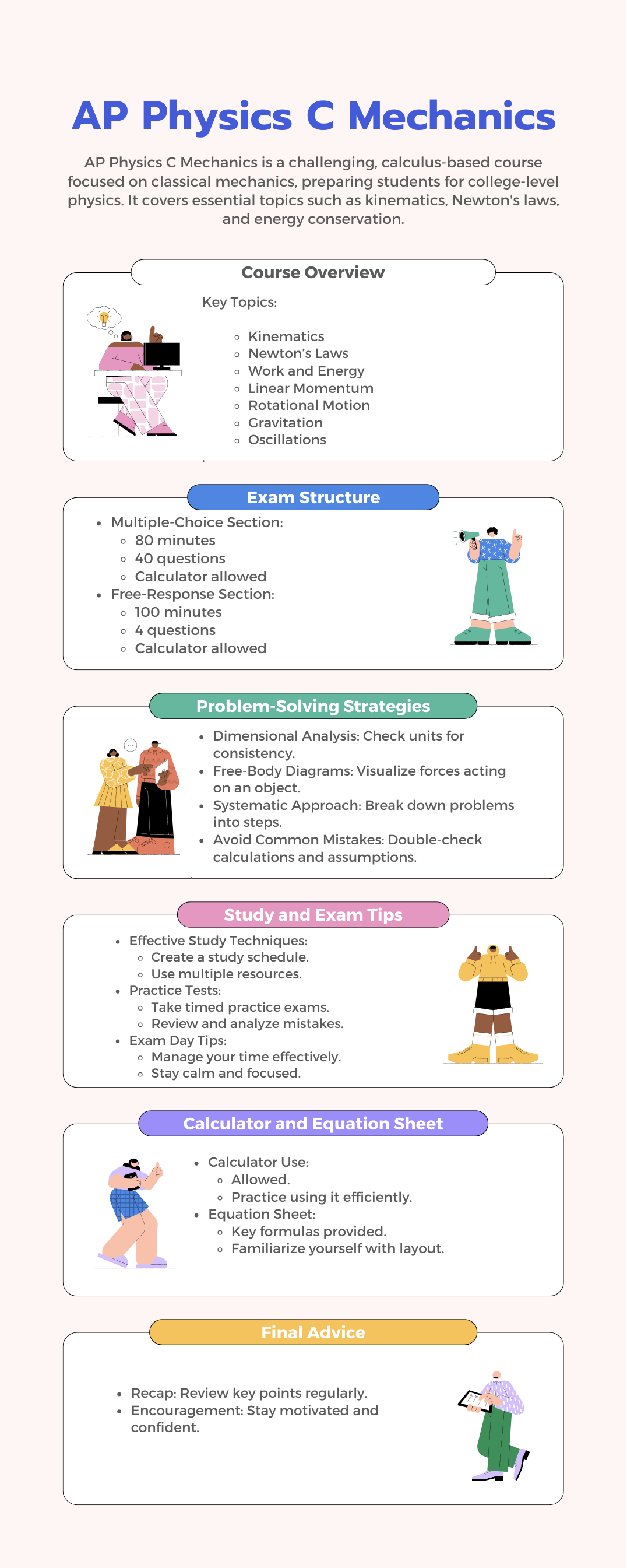Introduction to AP Physics C Mechanics
AP Physics C Mechanics is an AP course designed for high school students who have a strong interest in physics and are looking to challenge themselves with college-level material. The course explores the essential concepts of classical mechanics, a branch of physics focused on the motion of objects and the forces that influence this movement. Unlike AP Physics 1, this is a calculus-based, meaning that a solid understanding of calculus is required to grasp the concepts and solve the problems presented in the course.
Importance of AP Physics C Mechanics
AP Physics C Mechanics is important for several reasons:
- Foundation for Advanced Study: The course lays the groundwork for further study in physics, engineering, and other STEM (Science, Technology, Engineering, Mathematics) fields. It provides the essential concepts and skills needed for more advanced courses in college.
- Develops Analytical Skills: The course emphasizes problem-solving and critical thinking. Students learn to tackle complex problems systematically by breaking them into manageable components and applying physics principles to find solutions.
- College Credit and Placement: Performing well on the AP Physics C Mechanics exam can earn students college credit and/or advanced placement in college courses. This can save both time and money when working towards a college degree. Interested to know further? Check out How are AP and College credits related
- Practical Applications: Understanding mechanics is crucial for various real-world applications, from designing bridges and vehicles to understanding the motion of celestial bodies. The skills and knowledge gained in this course are directly applicable to many scientific and engineering challenges.
Exam Structure and Format
There are some big changes in exam format from 2025 onwards. Here is the official release of revision in AP Physics C Mechanics
The AP Physics C Mechanics exam is structured to test students’ understanding of the material and their ability to apply concepts to solve problems. The exam consists of two primary sections:
Multiple-Choice Section:
- Duration: 80 minutes
- Number of Questions: 40 questions
- No. of options: 4
- Scoring: Each question is worth the same amount of points. There is no penalty for guessing, so students are encouraged to answer every question.
- Calculator Policy: Calculators are permitted in the multiple-choice section.
Free-Response Section:
- Duration: 100 minutes
- Number of Questions: 4 questions
- Scoring: This section requires students to solve problems and explain their reasoning. Each question is divided into several parts, and partial credit is awarded for partially correct answers.
- Calculator Policy: Calculators are allowed in the free-response section.
Syllabus Covered by AP Physics C Mechanics
1. Kinematics
- Linear Motion: Describing motion along a straight line, including concepts of displacement, velocity, and acceleration.
- Vectors and Scalars: Distinguishing between scalar and vector quantities.
- Projectile Motion: Analyzing two-dimensional motion under the influence of gravity.
- Relative Velocity: Understanding the concept of velocity in different reference frames.
2. Newton’s Laws of Motion
- First Law (Inertia): Understanding that an object will remain at rest or in uniform motion unless acted upon by an external force.
- Second Law (F=ma): Relating the net force acting on an object to its mass and acceleration.
- Third Law (Action and Reaction): Every action has an equal and opposite reaction.
- Applications: Solving problems involving forces, friction, tension, and normal forces.
3. Work, Energy, and Power
- Work: Calculating work done by a force.
- Kinetic Energy: Understanding and calculating kinetic energy.
- Potential Energy: Gravitational and elastic potential energy.
- Conservation of Energy: Utilizing the principle of mechanical energy conservation in different scenarios.
- Power: Calculating power as the rate of doing work.
4. Systems of Particles and Linear Momentum
- Center of Mass: Determining the center of mass for a system of particles.
- Linear Momentum: Understanding and calculating linear momentum.
- Impulse: Establishing the relationship between impulse and the change in momentum.
- Conservation of Momentum: Solving problems involving collisions and explosions, including elastic and inelastic collisions.
5. Rotation
- Rotational Kinematics: Describing rotational motion, including angular displacement, velocity, and acceleration.
- Torque: Understanding torque and its effect on rotational motion.
- Rotational Inertia (Moment of Inertia): Calculating the moment of inertia for various objects.
- Rotational Dynamics: Applying Newton’s second law to rotational motion (τ = Iα).
- Angular Momentum: Understanding angular momentum and its conservation.
6. Oscillations
- Simple Harmonic Motion (SHM): Analyzing motion described by sinusoidal functions.
- Energy in SHM: Kinetic and potential energy in oscillatory systems.
- Pendulums: Understanding the motion of simple pendulums.
- Springs: Analyzing the motion of masses attached to springs (Hooke’s Law).
7. Gravitation
- Newton’s Law of Gravitation: Understanding the universal law of gravitation.
- Gravitational Potential Energy: Calculating gravitational potential energy in various contexts.
- Orbits of Planets and Satellites: Analyzing the motion of planets and satellites using Kepler’s laws and gravitational principles.
- Circular Motion: Applying concepts of centripetal force and acceleration to objects in circular motion.
Here’s the official release of AP Physics C Mechanics curriculum
Additional Topics
While the main focus of AP Physics C Mechanics is on the above topics, the course may also touch upon other areas that integrate or expand upon these core principles. This could include discussions on:
- Dimensional Analysis: Checking the consistency of units in equations.
- Free-Body Diagrams: Graphically representing forces acting on an object.
- Problem-Solving Techniques: Developing a systematic approach to solving physics problems.
%22%20transform%3D%22translate(5.3%205.3)%20scale(10.5039)%22%20fill-opacity%3D%22.5%22%3E%3Cellipse%20fill%3D%22%23d7d7d7%22%20rx%3D%221%22%20ry%3D%221%22%20transform%3D%22rotate(-90.8%2074.6%2032.4)%20scale(101%2029.90049)%22%2F%3E%3Cellipse%20fill%3D%22%23fff%22%20cx%3D%2266%22%20cy%3D%22255%22%20rx%3D%2268%22%20ry%3D%2268%22%2F%3E%3Cellipse%20fill%3D%22%23fff%22%20rx%3D%221%22%20ry%3D%221%22%20transform%3D%22matrix(1.84812%20100.98309%20-19.10213%20.3496%20101%2099.8)%22%2F%3E%3Cellipse%20fill%3D%22%23fff%22%20cx%3D%2281%22%20cy%3D%2255%22%20rx%3D%2227%22%20ry%3D%2221%22%2F%3E%3C%2Fg%3E%3C%2Fsvg%3E)
Equation Sheet and Calculator Usage in AP Physics C Mechanics
Equation Sheet
The AP Physics C Mechanics exam provides an equation sheet that includes key formulas and constants needed for the test. Understanding how to effectively use this sheet is crucial for exam success. Here’s what you can expect on the equation sheet and how to utilize it:
- Key Formulas: The equation sheet includes fundamental equations from different areas of mechanics, such as kinematics, dynamics, work and energy, rotational motion, and gravitation. These equations are meant to assist you during the exam, but you must know how and when to use them correctly.
- Constants: Important constants such as the acceleration due to gravity (g = 9.8 m/s²) and the universal gravitational constant (G = 6.67430 × 10^-11 N·m²/kg²) are provided. Familiarize yourself with these constants and how they apply to various problems.
- Units: The equation sheet includes the SI units for different quantities. Ensure that you understand these units and can convert between them if necessary.
- Common Equations:
- Kinematics:
 ,
,  ,
, 
- Newton’s Laws:
 ,
,  (equilibrium)
(equilibrium) - Work and Energy:
 ,
,  ,
, 
- Momentum:
 ,
, %22%20transform%3D%22translate(.5%20.5)%22%20fill%3D%22%23010101%22%20fill-opacity%3D%22.5%22%3E%3Cellipse%20cx%3D%22150%22%20cy%3D%229%22%20rx%3D%2212%22%20ry%3D%2216%22%2F%3E%3Cpath%20d%3D%22M69-10L63%201l14%2017zm46%2032l30-31-9%2030zM-7.4%201.1L-4-2.4%207.4%208.9%204%2012.4z%22%2F%3E%3C%2Fg%3E%3C%2Fsvg%3E)
- Rotational Motion:
 ,
, 
- Gravitation:
 ,
, 
Interested to know more? Read AP Physics C Equation sheet
Tips for Using the Equation Sheet:
- Familiarity: Spend time before the exam familiarizing yourself with the layout and content of the equation sheet.
- Practice: Use the equation sheet while practicing problems to get comfortable with quickly locating and applying the formulas.
- Understanding: Know what each equation represents and the conditions under which it applies. Blindly using formulas without understanding can lead to mistakes.
Calculator Use
A scientific or graphing calculator is allowed and can be extremely useful during the AP Physics C Mechanics exam. Here are guidelines and tips for using your calculator effectively:
- Allowed Calculators: Check the College Board’s list of approved calculators. Most scientific and graphing calculators from major brands like Texas Instruments, Casio, and Hewlett-Packard are allowed.
- Calculator Functions: Ensure your calculator has the following functions:
- Basic Arithmetic: Addition, subtraction, multiplication, division.
- Trigonometric Functions: Exploring sine, cosine, tangent, and their inverses.
- Exponents and Logarithms: Including natural logarithms.
- Statistical Functions: Mean, standard deviation, etc., if required.
- Graphing Capabilities: While not essential for all problems, graphing functions can help visualize certain problems.
3. Programming: Some calculators allow you to store programs and formulas. While this can be useful, ensure that you know how to retrieve and use them quickly during the exam.
4. Battery Check: Ensure your calculator has fresh batteries or is fully charged before the exam.
Tips for Effective Calculator Use:
- Practice: Use your calculator frequently while studying to become efficient in performing calculations quickly.
- Check Work: Use your calculator to verify calculations, but also understand the steps manually to catch any potential input errors.
- Avoid Over-Reliance: While calculators are helpful, avoid relying on them for all calculations. Understanding the underlying physics and being able to perform rough estimations is crucial.
- Time Management: Be mindful of the time spent on calculator-based problems. Efficient use of your calculator can save valuable time for other parts of the exam.
Practice Tests and Resources
- Official AP Practice Exams: Use practice exams provided by the College Board. These are designed to mimic the actual exam format and difficulty.
- Review Books: Invest in good review books such as “5 Steps to a 5” or “The Princeton Review”. These often include practice tests, summaries, and tips specifically tailored for the AP Physics C Mechanics exam.
- Online Platforms: Websites like Khan Academy and Tutoringmaphy’s AP Physics C Mechanics playlist offer free or low-cost courses and practice problems. These can be valuable for revisiting and reinforcing concepts.
- Flashcards: Use flashcards for quick reviews of key formulas, definitions, and concepts. Digital flashcard apps like Anki can be particularly helpful.
- AP Classroom: If your school provides access to the AP Classroom, use it for additional practice questions and to track your progress.
- Study Groups: Participate in or establish study groups with classmates. Discussing problems and concepts with peers can provide new insights and make studying more engaging.
Exam Day Tips
- Get a Good Night’s Sleep: Make sure to get sufficient rest the night before the exam. Being well-rested will aid in staying alert and focused during the test.
- Eat a Healthy Breakfast: Start your day with a nutritious breakfast to provide fuel for your brain. Avoid heavy or sugary foods that might cause a crash in energy levels.
- Arrive Early: Aim to arrive at the test center ahead of time to minimize any last-minute stress.
- Stay Calm and Positive: Keep a positive attitude. Remember that you have prepared well, and stay calm. Deep breathing exercises can assist in reducing anxiety levels.
- Read Instructions Carefully: Allocate time to thoroughly read the instructions for each section. Ensure comprehension of the tasks before beginning to answer questions.
- Time Management: Keep track of time. Allocate a specific amount of time for each section and adhere to it. Avoid spending excessive time on any single question. Proceed to the next question and return if time allows.
- Answer Every Question: Remember, there is no penalty for guessing on the multiple-choice section, so ensure to answer each question.
- Check Your Work: If you have time, review your answers. Double-check calculations and ensure you haven’t overlooked any questions.
FAQs on AP Physics C Mechanics
Q. Is AP Physics C Mechanics Hard?
AP Physics C Mechanics is often considered one of the more challenging AP courses due to its rigorous, calculus-based curriculum. It requires a solid understanding of both physics and calculus, making it more difficult than algebra-based physics courses. Students will need to grasp complex concepts and apply them to solve detailed problems. The course also demands strong analytical and problem-solving skills. However, with dedication, consistent study, and effective problem-solving strategies, students can succeed and find the subject highly rewarding.
Q. How Long Is the AP Physics C Mechanics Exam?
The AP Physics C Mechanics exam spans 90 minutes and comprises two primary sections:
- Multiple-Choice Section:
- Duration: 80 minutes
- Number of Questions: 40 questions
- Free-Response Section:
- Duration: 100 minutes
- Number of Questions: 4 questions
Q. How to Get a 5 on AP Physics C Mechanics?
Achieving a 5 on the AP Physics C Mechanics exam requires a thorough understanding of the material, effective study habits, and strong exam strategies. Here are some tips to help you aim for that top score:
- Master the Fundamentals: Ensure you have a strong grasp of the basic principles of mechanics and the necessary calculus skills.
- Consistent Practice: Regularly solve a variety of problems to strengthen your understanding and application of concepts.
- Use Quality Study Materials: Utilize textbooks, review books, online resources, and past exams to study and practice.
- Focus on Weak Areas: Identify and work on the topics where you struggle the most.
- Simulate Exam Conditions: Take timed practice tests to get used to the exam format and improve your time management.
- Review and Analyze: After practicing, thoroughly review your solutions and understand any mistakes to avoid repeating them.
- Seek Help When Needed: Don’t hesitate to ask teachers, join study groups, or use online forums for clarification on difficult topics.
Q. What Percent Is a 5 on AP Physics C Mechanics?
The exact percentage required for a 5 can vary depending on the difficulty of the exam in a given year and the scoring curve set by the College Board. Generally, to score a 5, you need to get around 50%. Typically, about 30% of yest takers score a 5.
Planning to rather take AP Physics 1? Check out How to study for AP Physics 1 exam
AP Physics C Mechanics and AP Calculus BC is a popular combo! Read Everything you need to know about AP Calculus BC
Confused about which AP Physics course is right for you? Read Which AP Physics should you take – AP Physics 1 or AP Physics C?




